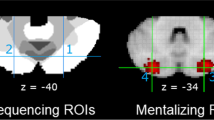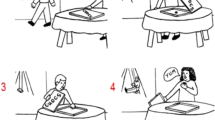Abstract
Recent advances in social neuroscience have highlighted the critical role of the cerebellum and especially the posterior cerebellar Crus in social mentalizing (i.e., theory of mind). Research in the past 5 years has provided growing evidence supporting the view that the posterior cerebellum builds internal action models of our social interactions to predict how other people’s actions will be executed, and what our most likely responses to these actions will be. This paper presents an overview of a series of fMRI experiments on novel tasks involving a combination of (a) the learning or generation of chronological sequences of social actions either in an explicit or implicit manner, which (b) require social mentalizing on another person’s mental state such as goals, beliefs, and implied traits. Together, the results strongly confirm the central role of the posterior cerebellar Crus in identifying and automatizing action sequencing during social mentalizing, and in predicting future action sequences based on social mentalizing inferences about others. This research program has important implications: It provides for the first time (a) fruitful starting points for diagnosing and investigating social sequencing dysfunctions in a variety of mental disorders which have also been related to cerebellar dysfunctions, (b) provides the necessary tools for testing whether non-invasive neurostimulation targeting the posterior cerebellum has a causal effect on social functioning, and (c) whether these stimulation techniques and training programs guided by novel cerebellar social sequencing insights, can be exploited to increase posterior cerebellar plasticity in order to alleviate social impairments in mental disorders.




Similar content being viewed by others
References
Schurz M, Radua J, Aichhorn M, Richlan F, Perner J. Fractionating theory of mind: A meta-analysis of functional brain imaging studies. Neurosci Biobehav Rev. 2014;42:9–34. https://doi.org/10.1016/j.neubiorev.2014.01.009.
Schurz M, Radua J, Tholen MG, Maliske L, Margulies DS, Mars RB, … Kanske P. Toward a hierarchical model of social cognition: a neuroimaging meta-analysis and integrative review of empathy and theory of mind. Psychol Bull. 2021;147(3):293–327. https://doi.org/10.1037/bul0000303
Van Overwalle F. Social cognition and the brain: a meta-analysis. Hum Brain Mapp. 2009;30(3):829–58. https://doi.org/10.1002/hbm.20547.
Fehlbaum LV, Borb R, Paul K, Eickhoff SB, Raschle NM. Early and late neural correlates of mentalizing : ALE meta-analyses in adults , children and adolescents. 2021;(July):1–16.
Guell X, Schmahmann J. Cerebellar functional anatomy: a didactic summary based on human fmri evidence. Cerebellum. 2020;19(1):1–5. https://doi.org/10.1007/s12311-019-01083-9.
Van Overwalle F, Baetens K, Mariën P, Vandekerckhove M. Social cognition and the cerebellum: a meta-analysis of over 350 fMRI studies. Neuroimage. 2014;86:554–72. https://doi.org/10.1016/j.neuroimage.2013.09.033.
Van Overwalle F, Baetens K, Mariën P, Vandekerckhove M. Cerebellar areas dedicated to social cognition? A comparison of meta-analytic and connectivity results. Soc Neurosci. 2015;10(4):337–44. https://doi.org/10.1080/17470919.2015.1005666.
Gabay AS, Radua J, Kempton MJ, Mehta MA. The ultimatum game and the brain: a meta-analysis of neuroimaging studies. Neurosci Biobehav Rev. 2014;47:549–58. https://doi.org/10.1016/j.neubiorev.2014.10.014.
Van Overwalle F, Ma Q, Heleven E. The posterior crus II cerebellum is specialized for social mentalizing and emotional self-experiences: a meta-analysis. Soc Cogn Affect Neurosci. 2020a;15(9):905–28. https://doi.org/10.1093/scan/nsaa124.
Van Overwalle F, Manto M, Cattaneo Z, Clausi S, Ferrari C, Gabrieli JDEE, … Leggio M. Consensus paper: cerebellum and social cognition. The Cerebellum. 2020;19(6):833–868. https://doi.org/10.1007/s12311-020-01155-1
Van Overwalle F, Van de Steen F, van Dun K, Heleven E. Connectivity between the cerebrum and cerebellum during social and non-social sequencing using dynamic causal modelling. Neuroimage. 2020c;206:116326. https://doi.org/10.1016/j.neuroimage.2019.116326.
Luyten P, Campbell C, Allison E, Fonagy P. The mentalizing approach to psychopathology: state of the art and future directions. Annu Rev Clin Psychol. 2020;16:297–325. https://doi.org/10.1146/annurev-clinpsy-071919-015355.
Cauda F, Geda E, Sacco K, D’Agata F, Duca S, Geminiani G, Keller R. Grey matter abnormality in autism spectrum disorder: an activation likelihood estimation meta-analysis study. J Neurol Neurosurg Psychiatry. 2011;82(12):1304–13. https://doi.org/10.1136/jnnp.2010.239111.
D’Mello AM, Crocetti D, Mostofsky SH, Stoodley CJ. Cerebellar gray matter and lobular volumes correlate with core autism symptoms. NeuroImage: Clinical. 2015;7:631–9. https://doi.org/10.1016/j.nicl.2015.02.007.
Gong, J., Wang, J., Qiu, S., Chen, P., Luo, Z., Wang, J., … Wang, Y. (2020). Common and distinct patterns of intrinsic brain activity alterations in major depression and bipolar disorder: voxel-based meta-analysis. Transl Psychiatry, 10(1). https://doi.org/10.1038/s41398-020-01036-5
Brady RO, Beermann A, Nye M, Eack SM, Mesholam-Gately R, Keshavan MS, Lewandowski KE. Cerebellar-cortical connectivity is linked to social cognition trans-diagnostically. Frontiers in Psychiatry. 2020;11(November). https://doi.org/10.3389/fpsyt.2020.573002
Bernard JA, Mittal VA. Dysfunctional activation of the cerebellum in schizophrenia. Clin Psychol Sci. 2015;3(4):545–66. https://doi.org/10.1177/2167702614542463.
Wang SSHS-H, Kloth AD, Badura A. The cerebellum, sensitive periods, and autism. Neuron. 2014;83(3):518–32. https://doi.org/10.1016/j.neuron.2014.07.016.
Courchesne E, Karns CM, Davis HR, Ziccardi R, Carper RA, Tigue ZD, … Courchesne RY. Unusual brain growth patterns in early life in patients with autistic disorder: an MRI study. Neurology. 2001;57(2):245–254. https://doi.org/10.1212/WNL.57.2.245
Limperopoulos C, Bassan H, Gauvreau K, Robertson RL, Sullivan NR, Benson CB, … DuPlessis AJ. Does cerebellar injury in premature infants contribute to the high prevalence of long-term cognitive, learning, and behavioral disability in survivors? Pediatrics. 2007;120(3):584–593. https://doi.org/10.1542/peds.2007-1041
Leggio M, Molinari M. Cerebellar sequencing: a trick for predicting the future. The Cerebellum. 2015;14(1):35–8. https://doi.org/10.1007/s12311-014-0616-x.
Baetens K, Firouzi M, Van Overwalle F, Deroost N. Involvement of the cerebellum in the serial reaction time task (SRT) (Response to Janacsek et al.). NeuroImage. 2020;220(February):117114. https://doi.org/10.1016/j.neuroimage.2020.117114.
Friston K, Herreros I. Active inference and learning in the cerebellum. Neural Comput. 2016;28(9):1812–1839. https://doi.org/10.1162/NECO_a_00863.
De Zeeuw CI, Lisberger SG, Raymond JL. Diversity and dynamism in the cerebellum. Nat. Neurosci. 2020;24(February). https://doi.org/10.1038/s41593-020-00754-9.
Leggio MG, Chiricozzi FR, Clausi S, Tedesco AM, Molinari M. The neuropsychological profile of cerebellar damage: the sequencing hypothesis. Cortex. 2011;47(1):137–44. https://doi.org/10.1016/j.cortex.2009.08.011.
Kampis D, Fogd D, Kovács ÁM. Nonverbal components of Theory of Mind in typical and atypical development. Infant Behav Dev. 2017;48:54–62. https://doi.org/10.1016/j.infbeh.2016.11.001.
Wimmer H, Perner J. Beliefs about beliefs: Representation and constraining function of wrong beliefs in young children’s understanding of deception. Cognition. 1983;13:103–28.
Saxe RR, Schulz LE, Jiang YV. Reading minds versus following rules: dissociating theory of mind and executive control in the brain. Soc Neurosci. 2006;1(3–4):284–98. https://doi.org/10.1080/17470910601000446.
Carlsson E, Miniscalco C, Gillberg C, Åsberg Johnels J. Assessing false-belief understanding in children with autism using a computer application: a pilot study. J Psycholinguist Res. 2018;47(5):1085–99. https://doi.org/10.1007/s10936-018-9579-2.
Langdon R, Coltheart M. Mentalising, schizotypy, and schizophrenia. Cognition. 1999;71:43–71.
Heleven E, van Dun K, Van Overwalle F. The posterior cerebellum is involved in constructing social action sequences: an fMRI study. Sci Rep. 2019;9(1). https://doi.org/10.1038/s41598-019-46962-7
Baron-Cohen S, O’Riordan M, Stone V, Jones R, Plaisted K. Recognition of Faux Pas by normally developing children and children with Asperger syndrome or high-functioning autism. J Autism Dev Disord. 1999;29(5):407–18.
Van Overwalle F, De Coninck S, Heleven E, Perrotta G, Ben Taib NO, Manto M, Mariën P. The role of the cerebellum in reconstructing social action sequences: a pilot study. Soc Cogn Affect Neurosci. 2019;14(5): 549–558. https://doi.org/10.1093/scan/nsz032
Baron-Cohen S, Leslie AM, Frith U. Mechanical, behavioural and Intentional understanding of picture stories in autistic children. Br. J. Dev. Psychol. 1986;4(2):113–125. https://doi.org/10.1111/j.2044-835x.1986.tb01003.x.
Ma Q, Heleven E, Funghi G, Pu M, Baetens K, Deroost N, Van Overwalle F. Implicit learning of true and false belief sequences. Front Psychol. 2021;12. https://doi.org/10.3389/fpsyg.2021.643594
Ma Q, Pu M, Heleven E, Haihambo NP, Baetens K, Baeken C, … Van Overwalle F. The posterior cerebellum supports implicit learning of social belief sequences. Cogn Affect BehavNeurosci. 2021. https://doi.org/10.3758/s13415-021-00910-z
Pu M, Heleven E, Delplanque J, Gibert N, Ma Q, Funghi G, Van Overwalle F. The posterior cerebellum supports the explicit sequence learning linked to trait attribution. Cognitive, Affective, and Behavioral Neuroscience. 2020;in press.
Li M, Ma Q, Baetens K, Pu M, Deroost N, Baeken C, … Van Overwalle F. Social cerebellum in goal-directed navigation. Soc Neurosci. 2021. https://doi.org/10.1080/17470919.2021.1970017
Schmahmann JD. The cerebellum and cognition. Neurosci Lett. 2019;688(April 2018):62–75. https://doi.org/10.1016/j.neulet.2018.07.005.
Nissen MJ, Bullemer P. Attentional requirements of learning: evidence from performance measures. Cogn Psychol. 1987;32(1):1–32. https://doi.org/10.1016/0010-0285(87)90002-8.
Özdem C, Brass M, Schippers A, Van der Cruyssen L, Van Overwalle F. The neural representation of mental beliefs held by two agents. Cogn Affect Behav Neurosci. 2019. https://doi.org/10.3758/s13415-019-00714-2.
Pu M, Ma Q, Heleven E, Haihambo NP, Van Overwalle F. The posterior cerebellum and inconsistent trait implications when learning the sequence of actions. Soc Cogn Affect Neurosci. 2021;(October 2020):1–11. https://doi.org/10.1093/scan/nsab037
Haihambo N, Ma Q, Baeken C, Deroost N, Baetens K, Heleven E, Van Overwalle F. Social thinking is for doing: the posterior cerebellum supports prediction of social actions based on personality traits. Soc Cogn Affect Neurosci. 2021. https://doi.org/10.1093/scan/nsab087
Frith CD, Frith U. How we predict what other people are going to do. Brain Res. 2006;1079(1):36–46. https://doi.org/10.1016/j.brainres.2005.12.126.
Molinari M, Masciullo M. The Implementation of predictions during sequencing. Front Cell Neurosci. 2019;13(October):1–10. https://doi.org/10.3389/fncel.2019.00439.
Pisotta I, Molinari M. Cerebellar contribution to feedforward control of locomotion. Front Hum Neurosci. 2014;8(JUNE):1–5. https://doi.org/10.3389/fnhum.2014.00475.
Cattaneo Z, Ferrari C, Ciricugno A, Heleven E, Schutter D, Manto M, Van Overwalle F. New horizons on non-invasive brain stimulation of the social and affective cerebellum. The Cerebellum. 2021;in press.
Heleven, Elien, van Dun, K., De Witte, S., Baeken, C., & Van Overwalle, F. (2021). The role of the cerebellum in social and non-social action sequences: a preliminary LF-rTMS study. Frontiers in Human Neuroscience: Brain Imaging and Stimulation.
Bersani FS, Minichino A, Fattapposta F, Bernabei L, Spagnoli F, Mannarelli D, … Chiaie RD. Prefrontocerebellar transcranial direct current stimulation increases amplitude and decreases latency of P3b component in patients with euthymic bipolar disorder. Neuropsychiatr Dis Treat. 2015;11:2913–2917. https://doi.org/10.2147/NDT.S91625
Dondé C, Neufeld NH, Geoffroy PA. The impact of transcranial direct current stimulation (tDCS) on bipolar depression, mania, and euthymia: a systematic review of preliminary data. Psychiatr Q. 2018;89(4):855–67. https://doi.org/10.1007/s11126-018-9584-5.
Minichino A, Bersani FS, Bernabei L, Spagnoli F, Vergnani L, Corrado A, … Chiaie RD. Prefronto–cerebellar transcranial direct current stimulation improves visuospatial memory, executive functions, and neurological soft signs in patients with euthymic bipolar disorder. Neuropsychiatr Dis Treat. 2015;11:2265–2270. https://doi.org/10.2147/NDT.S79108
Bation R, Mondino M, Le Camus F, Saoud M, Brunelin J. Transcranial direct current stimulation in patients with obsessive compulsive disorder: a randomized controlled trial. Eur Psychiatry. 2019;62:38–44. https://doi.org/10.1016/j.eurpsy.2019.08.011.
Bation R, Poulet E, Haesebaert F, Saoud M, Brunelin J. Transcranial direct current stimulation in treatment-resistant obsessive-compulsive disorder: an open-label pilot study. Prog Neuropsychopharmacol Biol Psychiatry. 2016;65:153–7. https://doi.org/10.1016/j.pnpbp.2015.10.001.
Escelsior A, Belvederi Murri M, Calcagno P, Cervetti A, Caruso R, Croce E, … Amore M. Effectiveness of cerebellar circuitry modulation in schizophrenia: a systematic review. J Nerv Ment Dis. 2019;207(11):977–986. https://doi.org/10.1097/NMD.0000000000001064
Van Overwalle F, Van de Steen F, Mariën P. Dynamic causal modeling of the effective connectivity between the cerebrum and cerebellum in social mentalizing across five studies. Cogn Affect Behav Neurosci. 2019;19(1):211–23. https://doi.org/10.3758/s13415-018-00659-y.
Clausi S, Olivito G, Lupo M, Siciliano L, Bozzali M, Leggio M. The cerebellar predictions for social interactions: theory of mind abilities in patients with degenerative cerebellar atrophy. Front Cell Neurosci. 2019;12(January):510. https://doi.org/10.3389/fncel.2018.00510.
De Zeeuw CI, Lisberger SG, Raymond JL. Diversity and dynamism in the cerebellum. Nature Neuroscience. 2020;24(February). https://doi.org/10.1038/s41593-020-00754-9
Funding
This work has been supported by an SRP57 grant by the Vrije Universiteit Brussel awarded to Frank Van Overwalle, Natacha Deroost, and Chris Baeken. There is no other funding source.
Author information
Authors and Affiliations
Corresponding author
Ethics declarations
Ethics approval
This article does not contain any studies with human participants or animals performed by any of the authors.
Conflict of interest
The authors declare no competing interests.
Additional information
Publisher's Note
Springer Nature remains neutral with regard to jurisdictional claims in published maps and institutional affiliations.
Rights and permissions
About this article
Cite this article
Van Overwalle, F., Pu, M., Ma, Q. et al. The Involvement of the Posterior Cerebellum in Reconstructing and Predicting Social Action Sequences. Cerebellum 21, 733–741 (2022). https://doi.org/10.1007/s12311-021-01333-9
Accepted:
Published:
Issue Date:
DOI: https://doi.org/10.1007/s12311-021-01333-9




